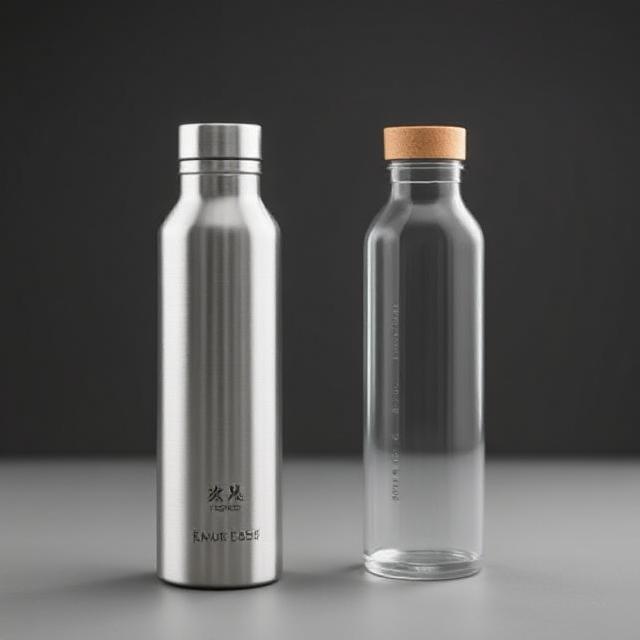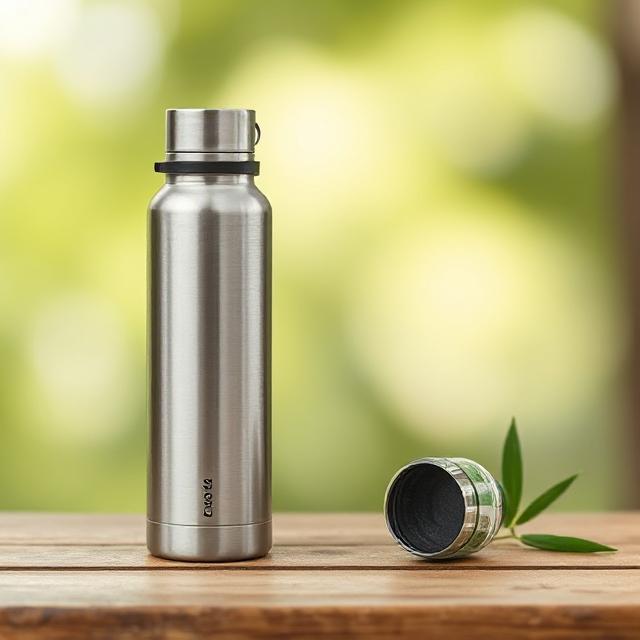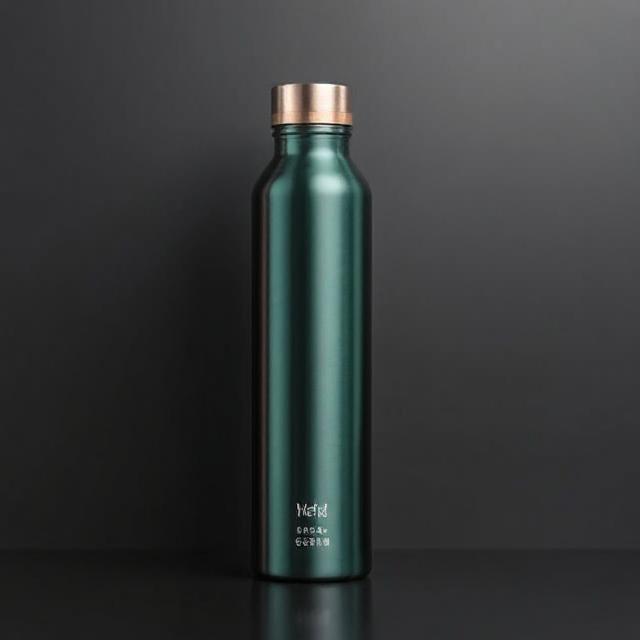Why Plastic-Free Matters
In today’s environmentally-conscious world, the shift toward plastic free water bottles has become more than just a trend—it’s a necessity. This comprehensive review examines 10 crucial benefits of making the switch, with each point thoroughly explained to provide clear, actionable insights.
From health protections to environmental impacts and everyday conveniences, we’ll explore why millions are abandoning plastic bottles for good. Whether you’re an eco-warrior, health enthusiast, or simply looking for a better water bottle, this guide will show you why plastic free water bottle is the way forward one compelling reason at a time.

1. Eliminates Toxic Chemical Exposure
Plastic bottles contain harmful chemicals like BPA, phthalates, and antimony that leach into water—especially when heated. Studies link these toxins to hormone disruption, infertility, and increased cancer risks. A plastic free water bottle made from stainless steel, glass, or certified non-toxic materials ensures zero chemical contamination. Unlike plastic, these materials don’t break down over time or release microplastics. Harvard research found BPA levels spike 69% in people using plastic bottles.
Because they are inert, glass and stainless steel will not react with liquids. This makes them safer for children, pregnant women, and health-conscious individuals. You completely eliminate this unseen danger by switching. Your body does not absorb petroleum compounds, and your water tastes cleaner. It’s one of the simplest ways to reduce daily toxin exposure while staying hydrated safely.
2. Dramatically Reduces Environmental Harm
Every minute, 1 million plastic bottles are sold globally—91% aren’t recycled. These bottles take 450+ years to decompose, polluting oceans and killing marine life. A single plastic free water bottle replaces 1,460 disposables over 4 years, slashing your waste footprint. Manufacturing plastic bottles consumes 17 million barrels of oil annually in the US alone. Non-plastic alternatives like stainless steel use more sustainable production methods and last decades.
They won’t fragment into microplastics that contaminate soil and water systems. By choosing reusable, you help reduce the 8 million metric tons of plastic entering oceans yearly. Many eco-bottles are made from recycled materials, creating a circular economy. Your switch inspires others, creating ripple effects. From cleaner beaches to healthier ecosystems, the environmental benefits are undeniable. It’s one of the most effective personal actions against plastic pollution.
3. Saves Significant Money Long-Term
While quality plastic free water bottles cost $20-$50 upfront, they save hundreds yearly. Compared to one reusable bottle, the average American spends $260 a year on bottled water, which is more than $1,300 over five years. The cost of even inexpensive bottled water ($1 per day) is $365 per year. Premium stainless steel bottles last 10+ years with proper care, offering 1000x ROI. Many brands offer lifetime warranties, unlike disposables you replace weekly.
Offices providing reusables save thousands on bottled water contracts. Travelers avoid airport markup prices by refilling. Some cities offer water station discounts for reusable users. The math is clear: after 3-6 weeks, your bottle pays for itself.
Factor in reduced medical costs from avoiding plastic toxins, and savings grow further. It’s a rare win-win where the eco-friendly choice is also financially smart. Your wallet and planet both benefit from this simple switch.

4. Superior Temperature Retention
Premium plastic free water bottles like double-walled stainless steel outperform plastic in thermal regulation. They keep ice frozen for 48+ hours and coffee hot for 24+ hours—plastic loses heat/cold in 2-3 hours. The vacuum insulation keeps hands dry by preventing moisture. This is ideal for athletes, travelers, and outdoor enthusiasts. Glass bottles with sleeves also maintain temperatures better than plastic.
You’ll never suffer lukewarm water again. The insulation works both ways—cold stays cold, hot stays hot—unlike plastic which absorbs ambient temperature. This feature alone justifies the upgrade for many users. Testers found Hydro Flask bottles maintained 34°F ice water after 24 hours in 70°F rooms.
For comparison, plastic bottles reached room temperature in 4 hours. Whether you’re hiking in heat or needing warm tea during winter commutes, temperature control transforms your drinking experience. It’s like having a portable mini-fridge.
5. Unmatched Durability & Longevity
While plastic bottles crack, stain, and degrade, plastic free alternatives withstand years of heavy use. Stainless steel is ideal for children and adventurers since it can withstand drops onto concrete. Glass bottles with protective silicone sleeves resist shattering. High-quality options endure:
- Extreme temperatures (-20°F to 400°F)
- Dishwasher cleaning cycles
- Outdoor elements (sun, rain, snow)
Unlike plastic that warps and leaks over time, these materials maintain structural integrity. Many users report bottles lasting 10+ years—some stainless steel models come with lifetime guarantees. They won’t absorb odors or flavors like plastic, staying fresh indefinitely. The durability makes them ideal for construction workers, athletes, and frequent travelers.
You’ll save the frustration of constantly replacing cracked plastic bottles. Even after years, a good stainless steel bottle looks and functions like new. This longevity is key to their sustainability—fewer replacements mean less waste. It’s a classic “buy it once” product that outlives dozens of disposable alternatives.
6. Healthier & More Hygienic
Plastic bottles develop bacterial slime in hard-to-clean crevices, especially screw threads. Studies found reused plastic bottles harbor 300,000+ bacteria per cm²—worse than toilet seats! Plastic free water bottles solve this with:
- Wide mouths for thorough cleaning
- Smooth, non-porous surfaces (no hiding spots)
- Dishwasher-safe materials
Stainless steel’s natural antimicrobial properties inhibit bacterial growth. Glass won’t absorb stains or smells from juices/coffee. Many designs feature removable silicone seals for deep cleaning. Hospitals prefer stainless steel for its sterility. Parents appreciate baby bottles without plastic’s chemical risks.
The hygiene difference is noticeable no more “funky bottle” taste. For those with weakened immune systems, this added protection is invaluable. Some brands like Klean Kanteen use antimicrobial copper lids for extra safety. Unlike plastic that degrades with cleaning, these materials withstand repeated sanitizing. Your water stays as clean as the first sip, every time. It’s the healthiest way to hydrate on the go.

7. Completely Microplastic-Free
Shocking studies reveal 93% of bottled water contains microplastics—up to 10,000 particles per liter. These plastic fragments accumulate in human organs, with unknown long-term effects. Plastic free water bottles guarantee zero microplastic contamination. Glass and stainless steel won’t shed particles, even when scratched. Research shows microplastics may:
- Cause cellular damage
- Disrupt gut microbiomes
- Carry toxic chemicals
By switching, you eliminate this invisible intake. Plastic bottles release more microplastics when exposed to heat—a major issue for left-in-car bottles. Even BPA-free plastics shed particles. The WHO warns about microplastics in drinking water, making non-plastic containers the safest choice.
Some stainless steel brands like S’well use medical-grade 18/8 steel that never interacts with liquids. For pure, untainted hydration, nothing beats glass or high-quality metal. It’s particularly crucial for children’s developing bodies. Every sip from a plastic free water bottle means fewer microplastics in your system—a clear health advantage.
8. Stylish & Personalized Designs
Gone are the days of boring reusable bottles. Today’s plastic free water bottles offer sleek aesthetics for every taste:
- Brushed stainless steel (professional look)
- Vibrant powder-coated colors
- Artistic glass etchings
- Sustainable bamboo accents
Brands like Soma and BKR collaborate with designers for fashion-forward hydration. Many companies offer:
✔ Custom engraving (great for gifts)
✔ Limited-edition artist series
✔ Interchangeable lid colors
The bottles become style statements—seen at gyms, offices, and cafes. Instagram-worthy designs make hydration more appealing. Some glass bottles mimic perfume bottles for elegance. Options for stainless steel range from simple to durable. In contrast to typical plastic bottles, these showcase individual flair..
The variety ensures everyone finds their perfect match from rose gold luxury to earthy matte finishes. Even functional features like carrying loops get designer treatments. It’s proof that eco-friendly can be visually stunning. Your plastic free water bottle becomes an extension of your personality, not just a container.
9. Lightweight Yet Rugged
Modern plastic free water bottles combine featherlight portability with extreme durability. Advanced materials like:
- Titanium (lighter than steel)
- Aircraft-grade aluminum
- Thin-but-strong borosilicate glass
make them easy to carry without sacrificing strength. The lightest stainless steel bottles weigh under 10oz—comparable to plastic. Brands like Hydro Flask use proprietary TempShield insulation that’s 30% lighter than competitors. Silicone sleeves add grip without bulk. Outdoor enthusiasts appreciate bottles that won’t weigh down backpacks.
Commuters enjoy easy one-handed carrying. Even large 32oz models feel surprisingly light when empty. The weight distribution is thoughtfully designed—no top-heavy spills. Some ultralight options cater to runners and cyclists. Unlike fragile plastic that cracks under pressure, these bottles withstand being crushed in bags.
They are suitable for everyday usage since they strike the optimal mix between heaviness and convenience. You get durability without the arm fatigue—a frequent complaint about older metal bottles. It’s lightweight hydration that lasts.

10. Lowers Your Carbon Footprint
Producing one plastic bottle emits 82.8g of CO2—multiply that by billions yearly. Plastic free water bottle slash this impact:
- Stainless steel has 95% lower lifetime emissions
- Glass production uses less fossil fuel
- Bamboo absorbs CO2 as it grows
A single reusable bottle prevents 167 plastic bottles annually—that’s 30lbs of CO2 saved per person. Manufacturing emissions are offset within 2-3 weeks of use. Many brands now use:
✔ 100% renewable energy in production
✔ Recycled materials (like post-consumer steel)
✔ Carbon-neutral shipping
Some companies plant trees for every bottle sold. The circular economy aspect is powerful—steel bottles are infinitely recyclable without quality loss. Even cleaning has less impact than constantly manufacturing disposables. Over 10 years, one reusable bottle prevents 1,500+ plastic bottles from entering waste streams. Your daily hydration choice becomes a climate action. When millions make this switch, the collective carbon reduction is enormous. It’s environmentalism in practice, one refill at a time.
Final Verdict: The Clear Choice for Health & Planet
After examining these 10 comprehensive benefits, the superiority of plastic free water bottles is undeniable. They represent the perfect intersection of:
✅ Health protection (no toxins/microplastics)
✅ Environmental stewardship (zero plastic waste)
✅ Practical excellence (durability, insulation, style)
Top Recommended Brands:
- Best Overall: Klean Kanteen (stainless steel)
- Best Glass: Lifefactory (shatter-resistant)
- Most Insulated: Hydro Flask (temperature control)
- Most Stylish: S’well (designer options)
Making the switch takes minimal effort but delivers maximum positive impact. Your body, wallet, and planet all reap the rewards. In a world drowning in plastic waste, choosing reusable is no longer optional—it’s essential.
This post contains affiliate links. If you purchase through them, I may earn a commission — at no extra cost to you.
